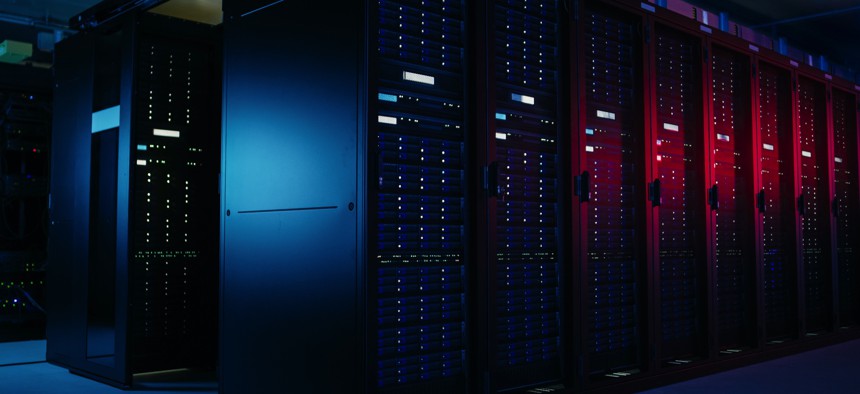White House Launches Supercomputing Consortium to Fight the Coronavirus
Scientists are tapping supercomputers to seek treatments and a vaccine.
The Trump administration unveiled a new initiative to help researchers worldwide harness a range of America’s most powerful high-performance supercomputing resources to deliberately accelerate new discoveries in the fight against COVID-19.
Through the COVID-19 High Performance Computing Consortium, scientists can tap into 16 of America’s top computing systems. Those systems will be made available by participating national laboratories, agencies, companies and academic institutions that have volunteered to share free compute time and resources—all to help put an end to the global health emergency. The new consortium was spearheaded by the White House Office of Science and Technology Policy, Energy Department, and tech-giant IBM over the last week.
Regarding what he deemed to be a “whole-of-America response,” U.S. Chief Technology Officer Michael Kratsios said in a statement Sunday that the nation is “coming together to fight COVID-19—and that means unleashing the full capacity of our world-class supercomputers to rapidly advance scientific research for treatments and a vaccine.”
The consortium is open to additional membership, but the partners that have initially offered up their resources at the time of launch include: IBM, Amazon Web Services, Google Cloud, and Microsoft from industry; the Massachusetts Institute of Technology and Rensselaer Polytechnic Institute from academia; the National Science Foundation and NASA from the government, as well as Argonne, Lawrence Livermore, Los Alamos, Oak Ridge and Sandia National laboratories.
Many of the labs and entities involved were already engaged in a variety of computer-driven work to curb and combat the virus ahead of the consortium’s launch. An OSTP official confirmed to Nextgov Monday that all ongoing research efforts related to COVID-19 at relevant agencies and labs will continue. On top of those efforts, the consortium will provide a fresh opportunity for new research projects to run on via free access to the partners' resources.
Anyone interested in tapping into the capabilities can submit relevant research proposals to the consortium through an online portal that’ll then be reviewed by what the website calls “the Consortium steering group.” That group, according to the OSTP official, will be made up of an expert panel of top scientists and computing researchers, who will work with proposers to quickly assess the public health benefit of the work and coordinate the allocation of the group’s computing assets. Each organization involved with the consortium, including the federal agencies and national labs, provides a representative to the panel, they said.
While the administration first began discussing the idea with Energy and IBM last week, a representative from the company told Nextgov Monday that “the concept originated with IBM,” which played a “central role in bringing the consortium together in a matter of days.”
The official said the consortium inherently “recognizes the role that supercomputing can play in accelerating scientific discovery in this global fight” against the virus, and added that members of the cadre bring together “an unprecedented collection of supercomputing power.”
Related: Oak Ridge National Lab Taps Supercomputers to Fight Coronavirus
Related: The Prognosis: Latest News on Coronavirus & National Security
The 16 systems represent more than 330 petaflops, 775,000 central processing unit cores, and 34,000 graphics processing units, “and counting,” which will essentially help scientists deliver results in hours or days, versus weeks or months. In a blog post regarding the announcement, Director of IBM Research Dario Gil said the high-performance computing systems will “allow researchers to run very large numbers of calculations in epidemiology, bioinformatics, and molecular modeling.”
To put the potential impacts further into perspective, Rensselaer Polytechnic Institute’s President Shirley Ann Jackson told Nextgov Monday that the school is sharing its own AiMOS, which is the most powerful supercomputer at any private university in America—and it’s rated at a sustained rate of 8 PetaFLOPS, or 8 quadrillion calculations per second.
“It is this type of power that is crucial to model a problem as complex as the threat from this coronavirus,” Jackson said.
Prior to the consortium’s launch Jackson said Rensselaer was already being contacted by other entities that were looking to collaborate on COVID-19 data analytics and molecular dynamics. Further, the institute had also already been actively working to attract researchers “who can model all facets of this disease, including spread, drug repurposing, and the development of new vaccines.” In that light, the approach that the consortium encompasses could prove to be imperative in enabling new computing connections to help combat the devastating effects of the pandemic.
“This is large, collaborative science in action,” Jackson said.
She and officials from other organizations involved in the consortium also confirmed that much of the work can be done remotely.





